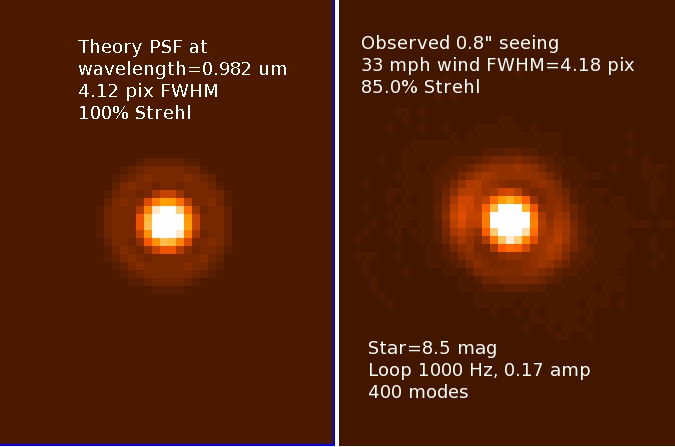Last week on Tuesday we closed the loop in the test tower, verifying our performance from the November run and validating our excellent wavefront control with MagAO.
We simulated 0.8” seeing (~15 cm r_0) in a 33 mph (~15 m/s) wind and closed the loop on an 8.5-mag guide star running at 1000 Hz with a pyramid modulation amplitude of 0.17 or about 3.5 lambda/D. We are correcting 400 modes, each one with an optimzed gain. The resulting image quality (right) is 85% Strehl at 982 nm effective wavelength, or about 65 nm residual wavefront error. The slight elongation manifested as subtle lobes on the first Airy ring at a position angle around ~60 deg. is most likely caused by time delay along the wind vector. Note that these images are linear scale, not log scale — and note the similarity of the ideal and the achieved PSFs!
Jared’s note at /uncategorized/a-better-closed-loop/ explains more about the differences between our simulated turbulence (limited to low and mid spatial frequencies by our 585-actuator DM) and Kolmogorov turbulence in the real atmosphere. We calculate that true atmospheric turbulence would add a moderate amount of wavefront error, and would bring our measured image quality of 65 nm WFE (85% Strehl) to more like 100 nm (68% Strehl).
Another difference between the test tower and the telescope is that our telescope simulator is double-pass on the ASM, so that our internal static error is doubled to ~75 nm rms as compared to what we should see on sky. Correcting for this effect improves our estimated on-sky WFE to ~70-80 nm rms (75-80% Strehl)! For comparison/sanity checking, LBT has thus far achieved 90% Strehl at H-band or ~85 nm rms WFE at best on sky in Arizona.
